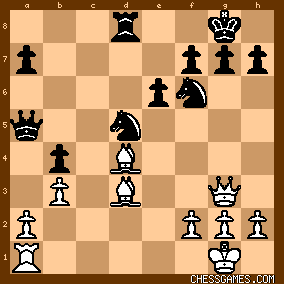| NeverAgain: 9.♘a5 - an odd decentralizing move. If the idea is to hinder ...c5, it certainly doesn't work. 12.♗d2 - another passive move. 12.♗e3, as in Capablanca vs E R Lundin, 1936, is better. 15.♘c5 - now White gives away a pawn for practically zero compensation. Simple 15.b3 was good enough to maintain balance. e.g.:
15.b3 ♖ac8 and now
a) 16.♘b2!? - the Knight aims for the powerful outpost on c4 and now Black should prefer
16...♕h5 (<Δ ...♗xf3 and ...♕xh2+>) 17.h3 ♗xf3 18.♕xf3 ♕f3 19.gxf3 ♘d5  to 16...♕xa2 17.♘c4 ♗xf3 18.gxf3 (<18.♕xf3? ♖xc4 and 19...♕xd2>) 18...♕a6 (<if the d6 Bishop retreats 18.♖a1 and 19.♖fc1 traps the black Queen>), when White has prospects of play along the half-open a- and g-files.
to 16...♕xa2 17.♘c4 ♗xf3 18.gxf3 (<18.♕xf3? ♖xc4 and 19...♕xd2>) 18...♕a6 (<if the d6 Bishop retreats 18.♖a1 and 19.♖fc1 traps the black Queen>), when White has prospects of play along the half-open a- and g-files. b) 16.♖fe1 ♘b6 17.♘c5 ♗xc5 with a further branch:
b1) 18.dxc5 ♖xc5 19.♖a1 - this is more of a pawn sacrifice than what happened in the game, as White gets the Bishop pair and play against the pinned b4 pawn. Another way to go about it is
b2) 18.♖xc5 ♖xc5 19.dxc5 ♗xf3 (else the Knight will establish itself on e5) 20.♕xf3 ♕xc5 21.♗e3 ♕a5 22.♗d4 ♘bd5 23.♖a1 ♖d8 24.♕g3 with a nice attacking position.

click for larger view
Note the amusing sideline 16...♗c6 17.♘e5 ♗xa4? 18.♖xc8 ♖xc8 19.♘xf7!  when White has a powerful attack. when White has a powerful attack. 22.♘e5? - this is a blunder. White should have played 22.♖d1 first. There follows an elegant little combination that gets Black two pieces for a Rook. That and his extra pawn spell  . . 28.♕d1 - 29.♕e3 was better, guarding the g1-a7 diagonal and keeping the a7 pawn in sights. 34.g4? - an ugly, desperate pawn push that leads to speedy demise. White had to bring the Rook back to c3 to cover his King. 35.♖xd5 - it's hard to criticize this move when its best alternative is resignation. Now after 35...♘xd5 there is no defence against ...♘f4+ and ...♗e2, when the white King is enmeshed in mating theats. An efficient exploitation by Korchnoi of White's feeble play. | 




